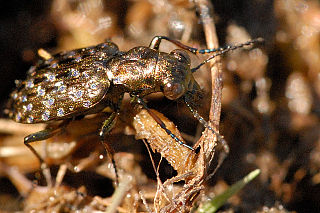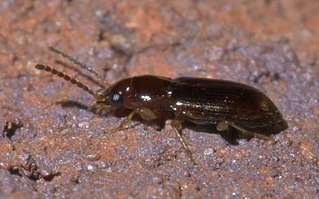Related Research Articles

Harpalus is a genus of ground beetle first described by Pierre André Latreille in 1802.

Agonum is a large genus of ground beetles in the subfamily Harpalinae, tribe Platynini. They are mid-sized to smallish beetles, typically with dark metallic hues – often reddish or bronze, but sometimes black, green etc.

Pterostichus is a very large genus of ground beetles with a Holarctic distribution in the subfamily Harpalinae. It has over 1,200 species. The beetles are predatory, but sometimes feed on strawberries. They can be found under rocks and prefer slightly moist, sandy soil although preferences differ between species.

Elaphrus is a genus in the beetle family Carabidae. There are at least 40 described species in Elaphrus.

Notiophilus is a genus of ground beetle native to the Palearctic, the Nearctic, the Near East and North Africa. Most known for their distinctive head shape and size-body ratio the genus is sometimes referred to as the springtail stalkers.

Stenus is a genus of semiaquatic rove beetles in the subfamily Steninae, and one of the largest genus in the kingdom Animalia, with some 2700 known species worldwide. They are predators of Collembola and other small arthropods. Adults have a protrusible labium with a sticky tip used in prey capture. To overcome the rapid escape of Collembola, the labium is protruded at high speed by hemolymph pressure, and immediately withdrawn, pulling the prey within the range of the mandibles. However, the labium tip does not easily stick to preys covered in scales or setae or that have a large body size. Stenus comma is more likely to catch such preys by lunging forward and grabbing them directly with its mandibles rather than using its labium. Stenus species are also known for "skimming" on the water surface using their pygidial gland secretions that act as a surfactant and rapidly propel the beetle fast forward, a phenomenon known as the Marangoni effect. Stenus comma has been seen to achieve a velocity of 0.75 m/s, and to cover a distance of up to 15 m if the secretion is continuous.

Bradycellus is a genus in the beetle family Carabidae. There are more than 120 described species in Bradycellus.

Platynus is a genus of ground beetles in the family Carabidae. There are more than 180 described species in Platynus.

Epicauta is a genus of beetles in the blister beetle family, Meloidae. The genus was first scientifically described in 1834 by Pierre François Marie Auguste Dejean. Epicauta is distributed nearly worldwide, with species native to all continents except Australia and Antarctica. Surveys have found the genus to be particularly diverse in northern Arizona in the United States. Few species occur in the Arctic, with none farther north than the southern Northwest Territory of Canada.

Oxytelus is a genus of spiny-legged rove beetles in the family Staphylinidae. There are more than 50 described species in Oxytelus.

Astenus is a genus of rove beetles.
References
- ↑ "Bledius Genus Information". BugGuide.net. Retrieved 2018-02-25.
- ↑ "Bledius Report". Integrated Taxonomic Information System. Retrieved 2018-02-25.
- ↑ "Browse Bledius". Catalogue of Life. Retrieved 2018-02-25.